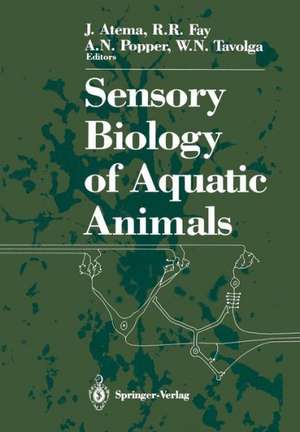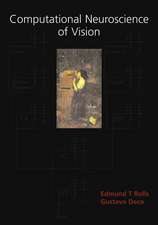Sensory Biology of Aquatic Animals
Editat de Jelle 1987, Richard R. Fay, William N. Tavolgaen Limba Engleză Paperback – 26 dec 2011
Preț: 983.50 lei
Preț vechi: 1199.39 lei
-18% Nou
Puncte Express: 1475
Preț estimativ în valută:
188.21€ • 204.37$ • 158.10£
188.21€ • 204.37$ • 158.10£
Carte tipărită la comandă
Livrare economică 22 aprilie-06 mai
Preluare comenzi: 021 569.72.76
Specificații
ISBN-13: 9781461283171
ISBN-10: 1461283175
Pagini: 988
Ilustrații: XXXVI, 936 p.
Dimensiuni: 170 x 244 x 55 mm
Greutate: 1.54 kg
Ediția:Softcover reprint of the original 1st ed. 1988
Editura: Springer
Colecția Springer
Locul publicării:New York, NY, United States
ISBN-10: 1461283175
Pagini: 988
Ilustrații: XXXVI, 936 p.
Dimensiuni: 170 x 244 x 55 mm
Greutate: 1.54 kg
Ediția:Softcover reprint of the original 1st ed. 1988
Editura: Springer
Colecția Springer
Locul publicării:New York, NY, United States
Public țintă
ResearchDescriere
This volume constitutes a series of invited chapters based on presentations given at an International Conference on the Sensory Biology of Aquatic Animals held June 24-28, 1985 at the Mote Marine Laboratory in Sarasota, Florida. The immediate purpose of the conference was to spark an exchange of ideas, concepts, and techniques among investigators concerned with the different sensory modalities employed by a wide variety of animal species in extracting information from the aquatic environment. By necessity, most investigators of sensory biology are specialists in one sensory system: different stimulus modalities require different methods of stimulus control and, generally, different animal models. Yet, it is clear that all sensory systems have principles in common, such as stimulus filtering by peripheral structures, tuning of receptor cells, signal-to-noise ratios, adaption and disadaptation, and effective dynamic range. Other features, such as hormonal and efferent neural control, circadian reorganization, and receptor recycling are known in some and not in other senses. The conference afforded an increased awareness of new discoveries in other sensory systems that has effectively inspired a fresh look by the various participants at their own area of specialization to see whether or not similar principles apply. This inspiration was found not only in theoretical issues, but equally in techniques and methods of approach. The myopy of sensory specialization was broken in one unexpected way by showing limitations of individual sense organs and their integration within each organism. For instance, studying vision, one generally chooses a visual animal as a model.
Cuprins
Detailed Chapter Contents.- I. Physical and Chemical Characteristics of Signals in the Aquatic Environment.- 1 The Molecular Nature of Chemical Stimuli in the Aquatic Environment.- The Identity of Chemical Stimulants of Behavior.- Stimulants of Feeding Behavior.- Deterrents of Feeding Behavior.- Substances Evoking Predator Avoidance and Alarm Responses.- Sex Attractants.- Substances Influencing Habitat Selection by Larvae.- Similarities Between External Chemical Signals and Internal Neuroactive Agents.- Summary.- 2 Distribution of Chemical Stimuli.- General Problem in Chemoreception.- Historic Perspective.- Spatial and Temporal Frequency Filtering.- Aquatic Stimulus Dispersal.- Physical Transport Processes.- Physiological and Behavioral Time Scales of Chemical Sampling.- Diffusion-Dominated Stimulus Dispersal.- “Micropatches”.- Oceanic Bacteria and Nutrient Uptake.- Algal Gametes.- Viscous Flow Fields.- Copepod Feeding Current.- Chemoreceptor Organs.- Turbulent Dispersal.- Turbulence and Chemoreception.- Gypsy Moth and Tsetse Fly.- Orientation in Patchy Odor Field.- Oceanic Fine Structure and Pancake Theory of Fish Orientation.- Information Currents.- Lobster Information Currents.- Conclusion and Summary.- 3 Light and Vision in the Aquatic Environment.- Light in the Sea.- Spectral Transmission of Water.- The Scattering of Light.- Surface Refractive Effects.- Radiance Distribution.- Image Transmission.- Photons and Retinal Image.- The Probability of Photon Capture.- The Brightness of Retinal Image.- Integration Area.- Integration Time.- Visual Noise.- Visual Pigments.- Paired Pigment System.- Visual Pigments and Sensitivity.- Visual Pigments and Visual Performance.- Color Vision.- Conclusions.- 4 Hydrodynamic and Acoustic Field Detection.- Spatial Analysis.- Monopole Sources.- Monopole-Field Equations.- Dipole Sources.- Dipole-Field Equations.- Directional Analysis.- Quadrupole and Higher-Order Moments.- Acoustic-Field Detection.- Hydrodynamic-Field Detection.- Source-Localization Algorithms.- Frequency Analysis.- A Frequency-Response Dilemma.- Old Mistakes and New Solutions.- Physics of Lateral-Line and Inner-Ear Sense Organs.- The Macula Neglecta.- The Boundary Layer Revisited.- Summary.- 5 Underwater Sound as a Biological Stimulus.- The Nature of Sound.- Governing Equations.- Plane Waves.- Spherical Waves.- Pressure-Velocity Ratios.- The Microvar.- Adequate Stimulus.- The Nature of the Coupling Between the Otolith and Cilia.- The Response of Hair Cells Without the Otolith.- Directional Cues.- Ambient Noise.- Underwater Sound Propagation.- Reflection.- Scattering.- Refraction.- Shallow Water Propagation.- Differences Between Underwater and Atmospheric Sound.- Summary.- 6 Detection of Weak Electric Fields.- Electric Fields in Natural Waters.- The Discovery of Bioelectric Fields.- The Origin of Bioelectric Fields.- The Representation of Bioelectric Fields.- Environmental Electric Fields.- Fields Induced by the Recipient Animal.- Behavioral Responses to Weak Electric Fields.- A New Sensory Modality Revealed.- Prey Detection, Sensitivity, and Frequency Response.- Orientation to Environmental Fields.- Detection of the Earth’s Magnetic Field.- Physics of Peripheral Sensory Apparatus.- Resistivity of the External Medium.- Potential Distribution Within the Animal.- Differential Operation and Common-Mode Rejection.- Physical Properties of Ampullary Canals.- Sensory Transduction and Nerve Coding.- Electroreceptor Mechanisms.- Detection of Temporal Field Characteristics.- Detection of Spatial Field Characteristics.- Sensory Mechanisms and Central Processing.- A Prey-Detection Algorithm.- Central Processing.- Summary.- II. Behavior: Survival Functions and Stimulus Acquisition.- 7 Behavioral Ecology and Sensory Biology.- Discriminating Food from Nonfood Items.- Food: Which Food Types Should be Eaten?.- How to Avoid Being Eaten.- With Whom to Mate?.- Social Relations.- Summary and Conclusions.- 8 Sensory Performance, Behavior, and Ecology of Fish.- Thresholds.- “Noise”.- Directional Perception.- Light.- Sound.- Chemicals.- The Enhancement of Sensory Awareness.- Multiple Stimulation.- Summary and Conclusions.- 9 Social Communication in the Aquatic Environment.- What Is Communication?.- Specialized Communication Sensors.- Special Problems of Communication in Aquatic Environments.- Speed of Signal Propagation.- Active Space.- Signal Attenuation Due to Geometrical Spreading, Absorption, and Scattering.- Background Noise and Receptor Sensitivity.- Signal Source Localization.- Electrical and Acoustic Communication in Mormyrid Fish.- Signal Range.- Acoustic Signalling in Pollimyrus isidori.- Audition in Mormyrids.- Nature of Electrical Signalling in Mormyrids.- Localization of Electric Signals by Mormyrids.- Signaller Identification and Signal Recognition.- Summary.- 10 The Comparative Neurology of Expectation: Stimulus Acquisition and Neurobiology of Anticipated and Unanticipated Input.- Stimulus Acquisition in Electroreception.- Plastic Corollary Discharge.- Efference Copy vs. Corollary Discharge.- Spike and Wave Signs of Central Expectation and Fluctuations of Readiness.- Fluctuations in the Expectation of Input.- Strategies for New Research.- Summary.- III. Signal Extraction: Receptor Cells and Sensory Systems.- III. A. Chemoreception.- 11 The Diversity of Chemoreceptors.- Behavioral Diversity.- Functional Diversity.- Generalists and Specialists.- Dynamic or Static Endings.- Internal and External Detection.- Structural Diversity.- Organ Systems.- Exposed or Protected Detectors.- Few or Many?.- Cilia.- Biochemical Structure.- Olfaction and Taste: Is There a Distinction?.- Proposed Definitions.- Diversity of Stimulatory Substances.- Numbers and Location of Receptors.- Sensory Cilium.- Crustacean Chemoreceptors.- Aesthetasc Hairs.- Esophageal Chemoreceptor in Homarus.- Funnel Canals in Dactyls of Decapod Crustacea.- Hedgehog Hairs.- Dorsal Organ of Decapod Larvae.- Conclusion.- Summary.- 12 Peripheral Filters and Chemoreceptor Cells in Fishes.- Olfactory Organ and Receptor Cell Distribution.- Taste Bud Anatomy and Distribution.- Receptor Mechanisms.- Sensitivity and Specificity to Amino Acids.- “Peripheral Filters”: Transduction Processes and Receptor Site Types.- Effects of Chemical Mixtures.- Summary.- 13 Organization of Chemosensory Systems Within the Brains of Bony Fishes.- Olfactory System.- Olfactory Nerve.- Olfactory Bulb.- Olfaction in Flatfish: Lopsided Smelling.- Terminal Nerve.- Gustatory System.- Gustatory Systems in Central Nervous System.- Common Chemical Sense.- Primary Sensory Nerves and Their Site of Central Termination.- Central Pathways.- Summary.- 14 Chemoreceptor Cells in Aquatic Invertebrates: Peripheral Mechanisms of Chemical Signal Processing in Decapod Crustaceans.- Stimulus Filtering.- Crustacean Chemoreceptor Cells.- General Constraints on Receptors.- The Determination of Stimulus Quality.- Narrow Tuning.- Mixture Effects.- The Determination of Stimulus Quantity.- Behavioral Thresholds.- Physiological Thresholds.- Range Fractionation.- Detection in Chemical Noise.- Interspecific Differences in Sensitivity.- Summary.- 15 Integration of Chemosensory Information in Aquatic Invertebrates.- Structural Organization.- Functional Organization.- The Discrimination of Odor Quality.- The Discrimination of Odor Quantity.- The Discrimination of Spatial and Temporal Aspects of Odors.- Summary.- III. B. Vision.- 16 Vision in Marine Invertebrates.- Invertebrate Visual Pigments.- Eye Design in Marine Invertebrates.- Invertebrate Optical Systems.- Summary.- 17 Vision and Mating Behavior in Limulus.- Circadian Rhythms in Retinal Structure and Function.- Laboratory Studies of Circadian Rhythms in Visual Sensitivity.- The Role of Vision in Limulus Mating Behavior.- Summary.- 18 Aquatic Adaptations in Fish Eyes.- Physical Constraints on Eye Design.- Light Collection.- Resolution.- The Structure of Fish Eyes.- Focus and Resolution.- Lens Quality.- The State of Focus.- Optic Field and Binocular Field.- Retinal Function During Growth.- Retinal Growth.- Visual Acuity and Retinal Growth.- Visual Sensitivity and Retinal Growth.- The Regulation of Retinal Growth.- Teleost Photoreceptors.- Structure.- Function.- Spatial Organization.- Retinomotor Movements.- Description.- Function.- Control.- Summary.- 19 Optics of Amphibious Eyes in Vertebrates.- Vision in Air and Water.- The Metamorphosis of Amphibian Ocular Optics.- Super Accommodation in Eyes of Diving Birds.- Conclusion—Questions Asked, Answers Needed.- Summary.- 20 How to Be Unseen: An Essay in Obscurity.- The Problem Defined.- Seeing Objects.- Abbreviated Natural History of Flatfish and Their Changes in Appearance.- Adaptive Behavior and Its Structural Basis.- Adaptive Parameters: A Note on Methodology.- Design Materials.- Chromatophore Types.- Morphological Markers.- Control Processes.- Nervous Pathway for Melanophore Control: Peripheral Aspects.- Nervous Pathway for Melanophore Control: Central Aspects.- Melanophore Dispersion: How Does It Happen?.- Peripheral Control of Other Chromatophores.- Camouflage as Visual Processing of Pattern and Texture.- Afterword.- Summary.- 21 The Visual System in Teleost Fishes: Morphological Patterns and Trends.- Optic Nerve.- Connections of the Retina.- Retinofugal Projections.- Retinopetal Projections.- Conclusions.- III. C. Mechanoreception.- III. C. 1. Hydrodynamic Reception.- 22 Diversity of Lateral Line Systems: Evolutionary and Functional Considerations.- Basic Anatomy of Mechanoreceptive Lateral Line System.- Variations in Canal Structure.- Variations in Neuromast Morphology.- Spatial Distribution of Receptor Organs.- Basic Distribution Pattern of Canals.- Basic Distribution of Superficial Neuromasts.- Morphological Constraints in the Evolution of Lateral Line Systems.- Convergent Trends.- Functional Implications of Morphological Variation.- Summary and Conclusions.- 23 Mechanical Factors in the Excitation of the Lateral Lines of Fishes.- Methods.- Steps in Excitation.- Step 1. The Source to Net Acceleration of the Medium Adjacent to the Lateral Line.- Step 2. From Net Motions in the Medium Close to Lateral Lines to Motions Inside Lateral Line Canals.- Step 3. From Motions of Liquid Inside Lateral Line Canals to Forces on Cupulae.- Step 4. The Force on the Cupula to the Activity in the Nerve.- Step 5. Patterns Between Neuromasts.- The Importance of Lateral Line to the Sprat.- The Behavior of Other Types of Lateral Line.- Poromitra.- Anoplogaster.- Penaeidae (Crustacea; Decapoda; Natantia).- A Discussion.- 24 Prey Identification and Prey Localization in Surface-Feeding Fish and Fishing Spiders.- Physical Principles.- Characteristics of Prey and Nonprey Wave Stimuli.- Water Surface as Stimulus Transmission Channel.- Sound Waves.- Useful Stimulus Parameters for Distance Determination.- Distance Determination in Surface-Feeding Fish.- Electrophysiological Results.- Behavioral Results.- Sound.- Some Speculative Considerations.- Stimulus Discrimination in Fishing Spiders.- Useful Stimulus Parameters for Prey and Nonprey Wave Discrimination.- Behavioral Results.- Diagrammatical Model of Results.- Summary.- 25 Surface Wave Reception in Invertebrates and Vertebrates.- A Note on the Use of the Term “Signal”.- Properties of Surface Waves.- Surface Wave Sensory Structures.- Invertebrates.- Vertebrates.- Amplitude and Frequency: Range, Sensitivity, and Discrimination.- Sensory and Behavioral Mechanisms: Predators and Prey.- Prey Identification.- Prey Localization.- Locating Wave Source Distance: Accuracy and Mechanisms.- Surface Waves and Predator Avoidance.- Communication by Surface Wave Signals.- Invertebrates.- Vertebrates.- Summary.- 26 The Representation of Hydrodynamic Parameters in the CNS of the Crayfish Procambarus.- A Circuit Monitoring Water Displacements.- Receptor Level.- The Arrangement of Thresholds and Frequency Response.- The Directionality of Response in Sensory Cells and Ventral Cord Interneurons.- Inhibitory Contrast Enhancements.- Discussion.- Displacement Receptors in the Water and Air.- Stimulus Intensity Coding.- Signal Frequency Range in this Pathway.- The Directionality of Response in this Pathway.- Neuronal Contrast Enhancements in the Pathway.- Dual Innervation of Receptors and Directional Subchannels in the Pathway.- Summary.- III. C. 2. Hearing.- 27 Role of the Fish Ear in Sound Processing.- The Fish Ear!.- Otolith Organs—Structure.- Pathways for Sound to the Ear.- What Do We Know About Signal Analysis?.- Mechanisms of Inner Ear Stimulation.- Sound Localization and Enhancement of Signal-to-Noise (S/N) Ratio.- Enhancement of S/N Ratio.- Sound Source Localization: Vectorial Analysis.- Frequency Analysis.- Temporal Analysis.- Cilia Length.- Regionalization.- Direct vs. Indirect Comparison.- Additional Considerations.- 28 Peripheral Adaptations for Spatial Hearing in Fish.- Cues Used for Directional Hearing in Air.- The Problem of Directional Hearing Underwater.- Early History.- Contemporary Views.- Directional and Nondirectional Response of Ears.- Principles of Stimulation and Directional Coding Hypotheses.- Problems to Be Solved.- Physiological Studies of Directional Hearing.- Central Nervous System.- Other Aspects of Directional Hearing.- Cocktail Party Effect.- Reflex Orientation.- Cues for the Structure of Acoustic Environments.- Summary and Conclusions.- 29 Central Connections of the Octavolateralis System: Evolutionary Considerations.- Patterns of Organization.- Primitive Pattern of Organization.- Patterns of Organization in Bony Fish.- Electrosensory Systems.- Evolutionary History of Electroreception.- Possible Origins of Teleost Electrosensory Pathways.- The Origin of the Octavolateralis System.- Summary.- Auditory Systems.- The Evolution of Central Auditory Pathways.- Inner Ear Receptor Projections.- Higher-Order Auditory Projections.- Audition and the Fish—Amphibian Transition.- Summary.- Conclusion.- III. C. 3. Equilibrium.- 30 Morphological Diversity of Equilibrium Receptor Systems in Aquatic Invertebrates.- Gravity Receptor Systems.- Gravity Orientation Without Specialized Gravity Receptor Systems.- Gravity Receptor Systems Using Cell Organelles.- Gravity Receptor Systems Lacking Hair Cells or Cuticular Sensory Hairs.- Gravity Receptor Systems with Hair Cells.- Gravity Receptor Systems with Cuticular Sensory Hairs.- Angular Acceleration Receptor Systems.- Angular Acceleration Receptor Systems with Hair Cells.- Angular Acceleration Receptor Systems with Cuticular Sensory Hairs.- Conclusions.- Summary.- 31 Equilibrium in the Vertebrates: Signals, Senses, and Steering Underwater.- Posture and Equilibrium.- Signals and Senses.- Vestibular Apparatus.- Variation in Vestibular Structure.- Vestibular Ultrastructural Organization.- Vestibular Physiology.- Steering: Posture and Locomotor Control.- Unusual Posture and Otolith Organ Structure.- Canal Sensitivity and Head Movements.- Extra-Vestibular Modulation of Posture.- Visual-Vestibular Interaction in Posture.- Other Sensory Influences on Posture.- Future Questions.- Conclusions.- III. D. Electroreception.- 32 The Electroreceptors: Diversity in Structure and Function.- Taxonomic Distribution.- Anatomy of Ampullary Electroreceptors.- Elasmobranches.- Teleosts.- Stimulus and Receptor Frequency Sensitivity.- Functional Anatomical Considerations and Biophysics.- Polarity and Sensitivity.- Noise Cancellation.- Tuberous Receptors.- Tuberous Receptor Morphology.- Electric Organ Discharge.- Enhancing Sensitivity: Impedance Matching and Noise Reduction.- Frequency Tuning of Tuberous Receptors.- Biophysics and the Origin of Tuning.- Coding Mechanissm of Tuberous Receptors.- Summary.- 33 The Neuronal Basis of Electrosensory Perception and Its Control of a Behavioral Response in a Weakly Electric Fish.- Neuroethological Research Strategies.- Neural Mechanisms of Jamming Avoidance Response (JAR).- The Study of Central Nervous Rules of Computation by Behavioral Experiments.- The Exploration of Neuronal Implementations.- General Lessons from the Study of the JAR.- Technical Difficulties in the Study of the CNS of Vertebrates.- The Nature of Distributed Parallel Processor.- The Emergence of Feature Detection and Behavioral Stimulus Specificity.- The Relation Between Neuronal Structural and Function.- Similarities to Neuronal Organization of Directional Hearing.- Speculations About the Evolution and Ontogeny of Neuronal System.- Summary.- IV. Adaptation and Sensory Systems.- 34 Sensory and Other Neural Traits and the Adaptationist Program: Mackerels of San Marco?.- Definitions of Adaptation.- Alternate Explanations of Design.- Evaluation of Hypotheses of Design.- Summary.- Author Index.- Animal Index.
















